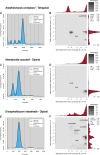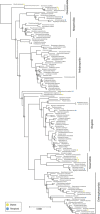Polyploidy is widespread in Microsporidia
- PMID: 38214524
- PMCID: PMC10845963
- DOI: 10.1128/spectrum.03669-23
Polyploidy is widespread in Microsporidia
Abstract
Microsporidia are obligate intracellular eukaryotic parasites with an extremely broad host range. They have both economic and public health importance. Ploidy in microsporidia is variable, with a few species formally identified as diploid and one as polyploid. Given the increase in the number of studies sequencing microsporidian genomes, it is now possible to assess ploidy levels across all currently explored microsporidian diversity. We estimate ploidy for all microsporidian data sets available on the Sequence Read Archive using k-mer-based analyses, indicating that polyploidy is widespread in Microsporidia and that ploidy change is dynamic in the group. Using genome-wide heterozygosity estimates, we also show that polyploid microsporidian genomes are relatively homozygous, and we discuss the implications of these findings on the timing of polyploidization events and their origin.IMPORTANCEMicrosporidia are single-celled intracellular parasites, distantly related to fungi, that can infect a broad range of hosts, from humans all the way to protozoans. Exploiting the wealth of microsporidian genomic data available, we use k-mer-based analyses to assess ploidy status across the group. Understanding a genome's ploidy is crucial in order to assemble it effectively and may also be relevant for better understanding a parasite's behavior and life cycle. We show that tetraploidy is present in at least six species in Microsporidia and that these polyploidization events are likely to have occurred independently. We discuss why these findings may be paradoxical, given that Microsporidia, like other intracellular parasites, have extremely small, reduced genomes.
Keywords: Microsporidia; k-mer; k-mer spectra; polyploidy; sequencing data; tetraploidy.
Conflict of interest statement
The authors declare no conflict of interest.
Figures






References
-
- Fokin SI, Di Giuseppe G, Erra F, Dini F. 2008. Euplotespora binucleata n. gen., n. sp. (Protozoa: Microsporidia), a parasite infecting the hypotrichous ciliate Euplotes woodruffi, with observations on microsporidian infections in ciliophora. J Eukaryot Microbiol 55:214–228. doi:10.1111/j.1550-7408.2008.00322.x - DOI - PubMed
MeSH terms
Grants and funding
LinkOut - more resources
Full Text Sources
Miscellaneous

